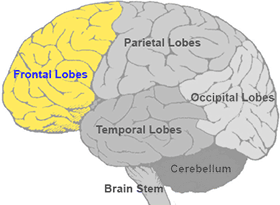Brain Map Frontal Lobes

The frontal lobes are located directly behind the forehead. The frontal lobes are the largest lobes in the human brain and they are also the most common region of injury in traumatic brain injury. The frontal lobes are important for voluntary movement, expressive language and for managing higher level executive functions. Executive functions refer to a collection of cognitive skills including the capacity to plan, organise, initiate, self-monitor and control one’s responses in order to achieve a goal. The frontal lobes are considered our behaviour and emotional control centre and home to our personality. There is no other part of the brain where lesions can cause such a wide variety of symptoms.
Damage to the frontal lobes can result in:
- Loss of simple movement of various body parts (Paralysis)
- Inability to plan a sequence of complex movements needed to complete multi-stepped tasks, such as making coffee (Sequencing)
- Loss of spontaneity in interacting with others
- Inability to express language (Broca's Aphasia)
- Loss of flexibility in thinking and persistence of a single idea or behaviour (Perseveration)
- Inability to focus on a task and to filter out distractions (Attention)
- Mood fluctuations (Emotional lability)
- Difficulty problem solving
- Difficulty inhibiting or controlling a response or impulse (Disinhibition)
- Reduced motivation, initiation and persistence on activities (Adynamia)
- Reduced awareness/insight into difficulties
- Changes in social behaviour
- Changes in personality
Contact ABIOS
abios@health.qld.gov.au